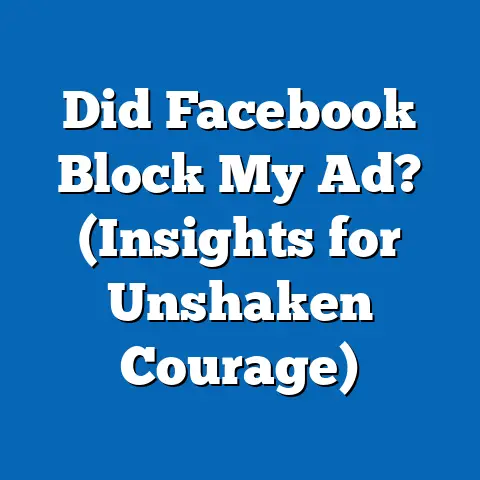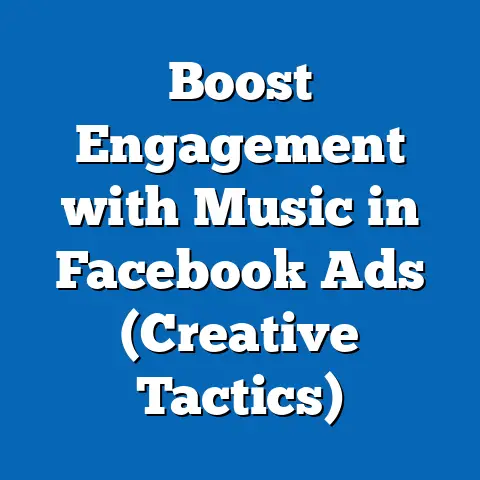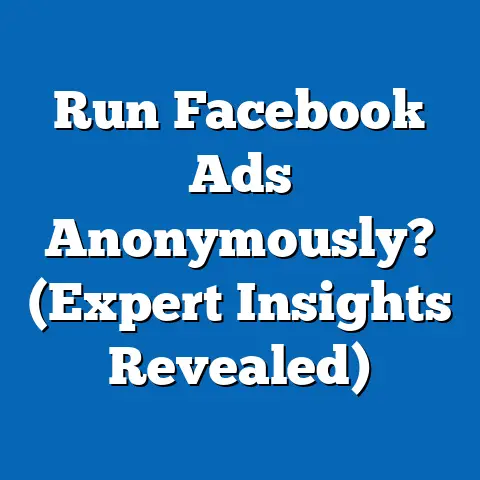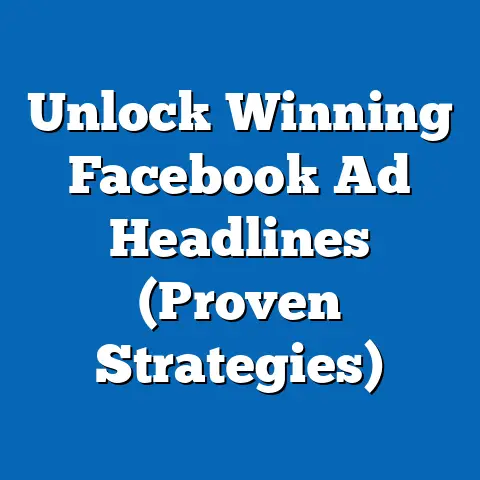Master Facebook Ad Uploads (Expert Tips for Success)
In the cutthroat world of digital marketing, where attention spans are shorter than ever, mastering Facebook ad uploads isn’t just a nice-to-have – it’s a necessity. Imagine launching a campaign with a blurry image or copy that doesn’t quite hit the mark. In today’s saturated digital landscape, that’s a recipe for wasted ad spend and missed opportunities.
I remember when I first started running Facebook ads, I thought the creative was just a box to tick. I quickly learned that the visuals and copy are your first (and sometimes only) chance to grab someone’s attention as they’re scrolling through their feed. According to recent statistics, Facebook ads continue to be a powerhouse for businesses, with a potential reach of over 2 billion users. But simply being on Facebook isn’t enough. You need to stand out.
This guide is designed to help you elevate your Facebook ad game, ensuring your campaigns not only get seen but also drive real results. I’m going to share my expert tips, learned through years of trial and error, on mastering the art of the Facebook ad upload. Let’s dive in and make sure your ads are primed for success!
Understanding Facebook Ad Formats
Facebook offers a diverse range of ad formats, each designed to achieve specific campaign objectives and resonate with different audiences. Understanding these formats is the first step towards creating compelling and effective ads. Let’s break down the most common ones:
-
Image Ads: These are the simplest and most common type of Facebook ad. They consist of a single image, headline, description, and call-to-action button. Image ads are great for driving traffic to your website or promoting a specific product.
-
Video Ads: Video ads are highly engaging and can be used to tell a story, showcase a product demo, or build brand awareness. They can be short and sweet (15 seconds) or longer and more in-depth.
-
Carousel Ads: Carousel ads allow you to display multiple images or videos in a single ad unit, each with its own headline, description, and link. These are perfect for showcasing a range of products, highlighting different features of a single product, or telling a story in a visually engaging way.
-
Slideshow Ads: Slideshow ads are similar to video ads but use a series of static images to create a moving visual experience. They’re a great option if you don’t have a video but still want to create a dynamic ad.
-
Instant Experience Ads (formerly Canvas Ads): These are full-screen, mobile-optimized ads that open when someone clicks on your ad. They can include a combination of images, videos, text, and interactive elements, providing a rich and immersive experience.
-
Collection Ads: Primarily used for e-commerce, Collection ads display a catalog of products with a focus on visual discovery. They often include a main video or image above several smaller product images.
Image Ads: These are the simplest and most common type of Facebook ad. They consist of a single image, headline, description, and call-to-action button. Image ads are great for driving traffic to your website or promoting a specific product.
Video Ads: Video ads are highly engaging and can be used to tell a story, showcase a product demo, or build brand awareness. They can be short and sweet (15 seconds) or longer and more in-depth.
Carousel Ads: Carousel ads allow you to display multiple images or videos in a single ad unit, each with its own headline, description, and link. These are perfect for showcasing a range of products, highlighting different features of a single product, or telling a story in a visually engaging way.
Slideshow Ads: Slideshow ads are similar to video ads but use a series of static images to create a moving visual experience. They’re a great option if you don’t have a video but still want to create a dynamic ad.
Instant Experience Ads (formerly Canvas Ads): These are full-screen, mobile-optimized ads that open when someone clicks on your ad. They can include a combination of images, videos, text, and interactive elements, providing a rich and immersive experience.
Collection Ads: Primarily used for e-commerce, Collection ads display a catalog of products with a focus on visual discovery. They often include a main video or image above several smaller product images.
Choosing the Right Format:
The best ad format for your campaign will depend on your specific goals and target audience. For example, if you’re trying to drive awareness for a new product launch, a video ad or Instant Experience ad might be a good choice. If you’re trying to drive sales for multiple products, a carousel ad or collection ad might be more effective.
I’ve found that testing different formats is crucial. What works for one audience or product might not work for another. Don’t be afraid to experiment and see what resonates best with your target market.
Takeaway: Understanding the different Facebook ad formats and their unique advantages is essential for creating effective campaigns. Choose the format that best aligns with your campaign objectives and target audience, and don’t be afraid to experiment with different options.
Best Practices for Image and Video Uploads
High-quality visuals are the cornerstone of any successful Facebook ad. Blurry images or poorly produced videos can instantly turn off potential customers and damage your brand’s credibility. Here’s a breakdown of best practices to ensure your image and video uploads are top-notch:
-
Image Specifications:
- Dimensions: The recommended dimensions vary depending on the ad placement. For News Feed ads, aim for 1200 x 628 pixels. For Stories ads, use 1080 x 1920 pixels. Always check Facebook’s ad specifications for the most up-to-date recommendations.
- File Size: Keep your image file size as small as possible without sacrificing quality. Facebook recommends a maximum file size of 30MB.
- Aspect Ratio: The aspect ratio refers to the width-to-height ratio of your image. Use a 1.91:1 aspect ratio for News Feed ads and a 9:16 aspect ratio for Stories ads.
- File Type: Use JPEG or PNG file formats for images.
-
Video Specifications:
-
Dimensions: Similar to images, video dimensions depend on the placement. Aim for 1280 x 720 pixels (720p) for News Feed ads and 1080 x 1920 pixels for Stories ads.
- File Size: Facebook recommends a maximum video file size of 4GB.
- Aspect Ratio: Use a 16:9 aspect ratio for landscape videos, 1:1 for square videos, and 9:16 for vertical videos.
- File Type: Use MP4 or MOV file formats for videos.
- Length: Keep your videos concise and engaging. Short videos (15-30 seconds) tend to perform best.
Image Specifications:
- Dimensions: The recommended dimensions vary depending on the ad placement. For News Feed ads, aim for 1200 x 628 pixels. For Stories ads, use 1080 x 1920 pixels. Always check Facebook’s ad specifications for the most up-to-date recommendations.
- File Size: Keep your image file size as small as possible without sacrificing quality. Facebook recommends a maximum file size of 30MB.
- Aspect Ratio: The aspect ratio refers to the width-to-height ratio of your image. Use a 1.91:1 aspect ratio for News Feed ads and a 9:16 aspect ratio for Stories ads.
- File Type: Use JPEG or PNG file formats for images.
-
Video Specifications:
-
Dimensions: Similar to images, video dimensions depend on the placement. Aim for 1280 x 720 pixels (720p) for News Feed ads and 1080 x 1920 pixels for Stories ads.
- File Size: Facebook recommends a maximum video file size of 4GB.
- Aspect Ratio: Use a 16:9 aspect ratio for landscape videos, 1:1 for square videos, and 9:16 for vertical videos.
- File Type: Use MP4 or MOV file formats for videos.
- Length: Keep your videos concise and engaging. Short videos (15-30 seconds) tend to perform best.
Video Specifications:
Dimensions: Similar to images, video dimensions depend on the placement. Aim for 1280 x 720 pixels (720p) for News Feed ads and 1080 x 1920 pixels for Stories ads.
The Importance of High-Quality Visuals:
Think of your ad as a billboard on a busy highway. You have a split second to capture someone’s attention and convince them to learn more. High-quality visuals are essential for making that first impression count.
I’ve seen firsthand how much of a difference quality makes. I worked with a client who was running ads with pixelated images, and their click-through rates were abysmal. After we upgraded their visuals to high-resolution images, their CTR more than doubled!
Tips for Creating Engaging Media:
- Use Contrasting Colors: Contrasting colors help your ad stand out in the busy News Feed.
- Add Text Overlays: Use text overlays to highlight key benefits or promotions. Keep the text concise and easy to read.
- Showcase Real People: Images and videos that feature real people tend to be more relatable and engaging.
- Tell a Story: Use your visuals to tell a compelling story that resonates with your target audience.
- Optimize for Mobile: Remember that most Facebook users access the platform on their mobile devices. Make sure your visuals look great on smaller screens.
Common Pitfalls to Avoid:
- Using Blurry or Pixelated Images: This is a major turnoff and can damage your brand’s credibility.
- Ignoring Aspect Ratios: Using the wrong aspect ratio can result in cropped or distorted visuals.
- Overloading Images with Text: Facebook limits the amount of text you can include in your images. Keep it concise and visually appealing.
- Using Low-Quality Videos: Poorly produced videos can make your brand look unprofessional.
Takeaway: Invest in high-quality visuals that are optimized for Facebook’s ad specifications. Use engaging media that tells a story and resonates with your target audience. Avoid common pitfalls that can detract from your ad’s effectiveness.
Crafting Compelling Ad Copy
Your ad copy is the voice of your ad, and it works hand-in-hand with your visuals to grab attention, convey your message, and drive action. It’s the bridge between a captivating image or video and a potential customer clicking that call-to-action button. Here’s how to craft ad copy that converts:
-
The Synergy Between Visuals and Copy:
Think of your visual and copy as a dynamic duo. Your visual grabs attention, and your copy seals the deal. They should complement each other, creating a cohesive and compelling message. For instance, if your image showcases a delicious-looking pizza, your copy might highlight the fresh ingredients and unbeatable price. * Guidelines for Attention-Grabbing Headlines:
Your headline is the first thing people read, so make it count. Keep it short, punchy, and relevant. Use strong verbs and focus on the key benefit of your product or service. Here are a few examples:
- “Get 50% Off Your First Order!”
- “Discover the Secret to Glowing Skin”
- “Learn a New Skill in Just 30 Days”
- Persuasive Body Text:
Your body text should expand on your headline and provide more details about your offer. Focus on the benefits, not just the features. Explain how your product or service can solve a problem or improve your customer’s life. Use clear and concise language, and avoid jargon. * The Importance of a Strong Call-to-Action (CTA):
Your CTA is the final push that motivates people to take action. Use strong action verbs and make it clear what you want people to do. Here are some effective CTAs:
- “Shop Now”
- “Learn More”
- “Sign Up”
- “Get Started”
- “Download Now”
The Synergy Between Visuals and Copy:
Think of your visual and copy as a dynamic duo. Your visual grabs attention, and your copy seals the deal. They should complement each other, creating a cohesive and compelling message. For instance, if your image showcases a delicious-looking pizza, your copy might highlight the fresh ingredients and unbeatable price. * Guidelines for Attention-Grabbing Headlines:
Your headline is the first thing people read, so make it count. Keep it short, punchy, and relevant. Use strong verbs and focus on the key benefit of your product or service. Here are a few examples:
- “Get 50% Off Your First Order!”
- “Discover the Secret to Glowing Skin”
- “Learn a New Skill in Just 30 Days”
- Persuasive Body Text:
Your body text should expand on your headline and provide more details about your offer. Focus on the benefits, not just the features. Explain how your product or service can solve a problem or improve your customer’s life. Use clear and concise language, and avoid jargon. * The Importance of a Strong Call-to-Action (CTA):
Your CTA is the final push that motivates people to take action. Use strong action verbs and make it clear what you want people to do. Here are some effective CTAs:
- “Shop Now”
- “Learn More”
- “Sign Up”
- “Get Started”
- “Download Now”
I always tell my clients to think about what they want the user to do immediately after seeing the ad. Make that action crystal clear in your CTA.
-
Examples of Successful Ad Copy:
Let’s look at a few examples of ad copy that works:
-
Example 1 (E-commerce):
- Headline: “New Arrivals! Shop Our Spring Collection”
- Body Text: “Freshen up your wardrobe with our latest spring styles. Get free shipping on orders over $50.”
-
CTA: “Shop Now”
- Example 2 (Lead Generation):
-
Headline: “Free Guide: 5 Ways to Boost Your Productivity”
- Body Text: “Struggling to stay organized? Download our free guide and learn proven strategies for maximizing your productivity.”
-
CTA: “Download Now”
- Example 3 (App Install):
-
Headline: “The Ultimate Fitness App – Try It Free!”
- Body Text: “Reach your fitness goals with our personalized workout plans and expert coaching. Download the app today and get a free 7-day trial.”
- CTA: “Install Now”
-
Examples of Successful Ad Copy:
Let’s look at a few examples of ad copy that works:
-
Example 1 (E-commerce):
- Headline: “New Arrivals! Shop Our Spring Collection”
- Body Text: “Freshen up your wardrobe with our latest spring styles. Get free shipping on orders over $50.”
-
CTA: “Shop Now”
- Example 2 (Lead Generation):
-
Headline: “Free Guide: 5 Ways to Boost Your Productivity”
- Body Text: “Struggling to stay organized? Download our free guide and learn proven strategies for maximizing your productivity.”
-
CTA: “Download Now”
- Example 3 (App Install):
-
Headline: “The Ultimate Fitness App – Try It Free!”
- Body Text: “Reach your fitness goals with our personalized workout plans and expert coaching. Download the app today and get a free 7-day trial.”
- CTA: “Install Now”
Example 1 (E-commerce):
- Headline: “New Arrivals! Shop Our Spring Collection”
- Body Text: “Freshen up your wardrobe with our latest spring styles. Get free shipping on orders over $50.”
-
CTA: “Shop Now”
- Example 2 (Lead Generation):
-
Headline: “Free Guide: 5 Ways to Boost Your Productivity”
- Body Text: “Struggling to stay organized? Download our free guide and learn proven strategies for maximizing your productivity.”
-
CTA: “Download Now”
- Example 3 (App Install):
-
Headline: “The Ultimate Fitness App – Try It Free!”
- Body Text: “Reach your fitness goals with our personalized workout plans and expert coaching. Download the app today and get a free 7-day trial.”
- CTA: “Install Now”
CTA: “Shop Now”
- Example 2 (Lead Generation):
Headline: “Free Guide: 5 Ways to Boost Your Productivity”
CTA: “Download Now”
- Example 3 (App Install):
Headline: “The Ultimate Fitness App – Try It Free!”
Takeaway: Craft compelling ad copy that works in synergy with your visuals. Use attention-grabbing headlines, persuasive body text, and strong calls-to-action to drive engagement and conversions.
Utilizing Facebook’s Ad Tools Efficiently
Facebook’s Ads Manager is your command center for creating, managing, and optimizing your ad campaigns. It’s a powerful tool, but it can be overwhelming if you don’t know how to navigate it effectively. Here’s a breakdown of key features and how to use them to your advantage:
-
Navigating the Ads Manager:
The Ads Manager interface is organized into three main sections: Campaigns, Ad Sets, and Ads.
- Campaigns: This is where you define your overall campaign objective, such as brand awareness, traffic, or conversions.
- Ad Sets: This is where you define your target audience, budget, and ad placement.
- Ads: This is where you create your individual ads, including your visuals, copy, and call-to-action.
Navigating the Ads Manager:
The Ads Manager interface is organized into three main sections: Campaigns, Ad Sets, and Ads.
- Campaigns: This is where you define your overall campaign objective, such as brand awareness, traffic, or conversions.
- Ad Sets: This is where you define your target audience, budget, and ad placement.
- Ads: This is where you create your individual ads, including your visuals, copy, and call-to-action.
I recommend starting by setting up your campaign objective first. This will help Facebook optimize your ads for the desired outcome.
-
The Importance of A/B Testing:
A/B testing (also known as split testing) is the process of comparing two versions of your ad to see which one performs better. You can A/B test different headlines, images, body text, CTAs, and even target audiences.
To set up an A/B test, simply create two versions of your ad with a slight variation. Run both ads simultaneously and track the results. The ad with the higher click-through rate, conversion rate, or other relevant metric is the winner. * Using Facebook’s Audience Insights:
Facebook’s Audience Insights tool provides valuable data about your target audience, including their demographics, interests, behaviors, and purchase patterns. You can use this information to tailor your ad copy, visuals, and targeting to resonate with specific segments.
To access Audience Insights, go to the Ads Manager and click on “Tools” in the top navigation. Then, select “Audience Insights.” You can explore different audiences based on interests, demographics, or connections to your Facebook page. * Tracking Performance Metrics:
Monitoring your ad performance is crucial for identifying what’s working and what’s not. Here are some key metrics to track:
- Reach: The number of unique people who saw your ad.
- Impressions: The number of times your ad was displayed.
- Click-Through Rate (CTR): The percentage of people who clicked on your ad after seeing it.
- Conversion Rate: The percentage of people who completed a desired action (e.g., made a purchase, filled out a form) after clicking on your ad.
- Cost Per Click (CPC): The average cost you paid for each click on your ad.
- Cost Per Conversion (CPC): The average cost you paid for each conversion.
The Importance of A/B Testing:
A/B testing (also known as split testing) is the process of comparing two versions of your ad to see which one performs better. You can A/B test different headlines, images, body text, CTAs, and even target audiences.
To set up an A/B test, simply create two versions of your ad with a slight variation. Run both ads simultaneously and track the results. The ad with the higher click-through rate, conversion rate, or other relevant metric is the winner. * Using Facebook’s Audience Insights:
Facebook’s Audience Insights tool provides valuable data about your target audience, including their demographics, interests, behaviors, and purchase patterns. You can use this information to tailor your ad copy, visuals, and targeting to resonate with specific segments.
To access Audience Insights, go to the Ads Manager and click on “Tools” in the top navigation. Then, select “Audience Insights.” You can explore different audiences based on interests, demographics, or connections to your Facebook page. * Tracking Performance Metrics:
Monitoring your ad performance is crucial for identifying what’s working and what’s not. Here are some key metrics to track:
- Reach: The number of unique people who saw your ad.
- Impressions: The number of times your ad was displayed.
- Click-Through Rate (CTR): The percentage of people who clicked on your ad after seeing it.
- Conversion Rate: The percentage of people who completed a desired action (e.g., made a purchase, filled out a form) after clicking on your ad.
- Cost Per Click (CPC): The average cost you paid for each click on your ad.
- Cost Per Conversion (CPC): The average cost you paid for each conversion.
I always tell my clients to focus on the metrics that are most relevant to their campaign objectives. If you’re trying to drive brand awareness, focus on reach and impressions. If you’re trying to drive sales, focus on conversion rate and cost per conversion.
Takeaway: Master Facebook’s Ads Manager by navigating the platform effectively, utilizing A/B testing to optimize your ads, leveraging Audience Insights to tailor your targeting, and tracking performance metrics to make data-driven adjustments.
Troubleshooting Common Upload Issues
Even with the best planning and preparation, you might encounter hiccups during the ad upload process. Here are some common issues and how to resolve them:
-
Error Messages:
Facebook’s Ads Manager can sometimes throw cryptic error messages your way. The best approach is to carefully read the message and try to understand what it’s telling you. Common errors include:
- Invalid Image Size or Format: Double-check your image dimensions and file type against Facebook’s specifications.
- Text Overlay Limit Exceeded: Reduce the amount of text in your image.
- Ad Policy Violation: Review Facebook’s advertising policies to ensure your ad complies with their guidelines.
- Format Rejection:
Sometimes, Facebook might reject your ad format even if it seems to meet the specifications. This could be due to a bug in the system or an issue with the file itself. Try re-uploading the ad or using a different file format. * Prolonged Processing Times:
If your ad is taking a long time to process, it could be due to a large file size or a slow internet connection. Try optimizing your file size and ensuring you have a stable internet connection. * Ensuring Compliance with Facebook’s Advertising Policies:
Facebook has strict advertising policies that you must adhere to. Violating these policies can result in your ad being disapproved or your account being suspended. Here are some key areas to focus on:
- Misleading Claims: Avoid making false or exaggerated claims about your product or service.
- Sensitive Topics: Be careful when advertising on sensitive topics such as politics, religion, or health.
- Prohibited Content: Do not promote illegal or harmful products or services.
- Personal Attributes: Do not target people based on their personal attributes such as race, ethnicity, or sexual orientation.
Error Messages:
Facebook’s Ads Manager can sometimes throw cryptic error messages your way. The best approach is to carefully read the message and try to understand what it’s telling you. Common errors include:
- Invalid Image Size or Format: Double-check your image dimensions and file type against Facebook’s specifications.
- Text Overlay Limit Exceeded: Reduce the amount of text in your image.
- Ad Policy Violation: Review Facebook’s advertising policies to ensure your ad complies with their guidelines.
- Format Rejection:
Sometimes, Facebook might reject your ad format even if it seems to meet the specifications. This could be due to a bug in the system or an issue with the file itself. Try re-uploading the ad or using a different file format. * Prolonged Processing Times:
If your ad is taking a long time to process, it could be due to a large file size or a slow internet connection. Try optimizing your file size and ensuring you have a stable internet connection. * Ensuring Compliance with Facebook’s Advertising Policies:
Facebook has strict advertising policies that you must adhere to. Violating these policies can result in your ad being disapproved or your account being suspended. Here are some key areas to focus on:
- Misleading Claims: Avoid making false or exaggerated claims about your product or service.
- Sensitive Topics: Be careful when advertising on sensitive topics such as politics, religion, or health.
- Prohibited Content: Do not promote illegal or harmful products or services.
- Personal Attributes: Do not target people based on their personal attributes such as race, ethnicity, or sexual orientation.
I always recommend reviewing Facebook’s advertising policies thoroughly before launching any campaign. It’s better to be safe than sorry.
Takeaway: Be prepared to troubleshoot common upload issues by carefully reading error messages, optimizing your file sizes, and ensuring compliance with Facebook’s advertising policies.
Conclusion
Mastering Facebook ad uploads is not just about technical proficiency; it’s about understanding the nuances of the platform, the psychology of your audience, and the art of creating compelling content. By implementing the tips and strategies discussed in this guide, you can elevate your ad game and achieve greater success with your Facebook advertising campaigns.
Remember, the landscape of digital advertising is constantly evolving. Stay curious, keep learning, and never stop experimenting. Those who adapt quickly and embrace new techniques will reap the rewards of increased engagement, conversions, and ultimately, business growth.
Now it’s your turn! Take action today to refine your ad upload processes and start seeing better results from your Facebook advertising efforts.
Call to Action:
I’d love to hear about your experiences with Facebook ad uploads. Share your challenges, successes, and any tips you’ve learned in the comments section below. And don’t forget to follow for more insights and updates on mastering digital marketing strategies!





